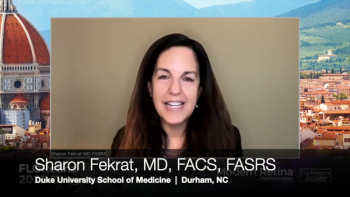
- Ophthalmology Times Europe January/February 2025
- Volume 21
- Issue 1
- Pages: 32 - 34
Advanced therapies in neovascular AMD and DMO: Experts weigh in
A clinician panel illuminates current treatment paradigms and best practices for reducing treatment burden
In a recent
The panel was hosted by John Kitchens, MD, a vitreoretinal surgeon with Retina Associates of Kentucky in Lexington, Kentucky. Joining Dr Kitchens were Richard Gale, PhD, MEd, MBChB, BSc, FRCP, FRCOphth, a consultant medical ophthalmologist and professor at Hull York Medical School, York, England, and Michael W. Stewart, MD, a professor and the chairman of ophthalmology at Mayo Clinic in Jacksonville, Florida.
Below are some of the highlights from their wide-ranging conversation on treatment goals, the current therapeutic landscape and clinical application of the treat-and-extend strategy.
Evolution of anti-VEGF agents and unmet needs in retinal diseases
Modern therapies for nAMD and DMO are a century in the making, Prof Stewart said, and retina specialists have a full stable of mainstay ocular therapies to choose from in the 21st century. He cited
Prof Gale said therapeutics like the ones Prof Stewart mentioned have changed the landscape for patients with AMD. “These blinding disorders can now have successful treatment in terms of halting visual loss. Around about a third of individuals have had some restoration or significant restoration of vision,” he said. “That means the rate of registration of blindness for neovascular AMD has been approximately halved.”
That “paradigm shift,” Prof Gale said, manifests in societal benefits, such as increased independence and reduced burden of care for patients and their families. Halting the progression of retinal disease
and restoring visual acuity also both result in broader healthcare outcomes; for example, Prof Gale said, severe vision loss can be associated with slip-and-fall incidents, mobility-limiting injuries and even premature death.
Prof Stewart also pointed out that, since 2004, when anti-VEGF injections first began to see wider adoption, clinicians have accumulated plenty of positive safety data. He cited this as evidence of how far retinal therapies have come. “We can say that from the standpoint of ocular safety, these drugs really have very good safety profiles,” he said. “They are, of course, not perfect, not [that] any drugs are. But the reality is, with respect to intraocular pressure changes, intraocular inflammation, very low risk of infection that follows any invasive intraocular procedures, these drugs really have excellent profiles.” In limited cases, he added, patients may have comorbidities which limit the suitability of anti-VEGF agents; those with AMD may experience age-related problems, while patients with diabetes are at higher risk of systemic cardiovascular events. But for the most part, he said, these adverse effects are not common enough to limit accessibility. “It’s not very common that [systemic problems] actually adversely influence our choice of medications,” he said.
Advantages of the molecular structure of aflibercept
Dr Kitchens introduced the next chapter of the discussion by mentioning the
“The molecule itself is a recombinant protein, and therefore it has a low likelihood of inducing inflammation within the eye,” Prof Gale said. This translates into a lower incidence of anti-drug antibodies, and thus a lower likelihood of reactions such as iritis or vitritis.
Prof Stewart further explained how this differentiates aflibercept 2 mg from other therapeutics. “Of all the anti-VEGFs we have, it’s the only one that’s not an antibody-based molecule,” he said. Whereas other anti-VEGF molecules are antibody-derived, then humanised to make them more immunologically compatible, all the protein sequences within aflibercept are native to the human body, he said.
“The consequences of binding sequences from those two receptors is that you bind all of the ligands that go to those two receptors,” Prof Stewart continued. “We know, for example, that binding to the isoforms of VEGF-A and inhibiting their interaction with VEGF-2 is key to stopping all of our anti-angiogenic processes. But the fact that there are VEGFR-1 binding sequences on aflibercept means you also bind the ligands to VEGFR-1, and those include placental growth factor, VEGF-B and Galectin-1. And so when you put it all together, it’s a multitargeted drug, and it’s that way based upon its actual structure.”
Additionally, aflibercept binds to both sides of the VEGF dimer, in what Prof Stewart described as a “two-fisted grasp.” “As a result, it has a very low dissociation constant. You have a very high binding affinity. You put all of that together, as well as a reasonably long intravitreal half-life... You put together a molecule that has very good pharmacokinetic principles.”
Treat-and-extend strategy with aflibercept
One of the advantages of aflibercept 2 mg, said Dr Kitchens, is that it’s “very predictable,” which can support clinicians in developing a
“We’ve learned quite a few things about neovascular AMD and diabetic macular oedema,” Prof Gale said. “When I talk to my patients, I talk to them about AMD and neovascular AMD being a lifelong disorder, requiring, quite often, lifelong treatment. And so, I explain, we want to get the right treatment for them, at the right injection frequency to maintain disease suppression and to maintain vision as well as possible.”
“In my mind, treat and extend enables us, as clinicians, to find that correct treatment interval,” he continued. The personalised interval between treatments allows the patient and clinician to maximise efficiency, he said. “We continue to treat, until, perhaps, it begins to relapse. We know that interval is an important marker for us, of when to just rein back that retreatment interval... We can find the appropriate interval, in the medium- to long-term, for an individual.”
The resulting customised care protocol benefits everyone, Prof Gale concluded. “It’s a very safe and effective way of minimising burden for ourselves, our patients and our healthcare system, while giving the maximum treatment effect,” he said.
Assessing new therapies for retinal diseases
Dr Kitchens encouraged his colleagues to
“Now, with anti-VEGF suppression, we have so many good drugs available to us,” Prof Stewart said. “When you look at the recent drug approvals, they’ve all been non-
inferiority trials... [But] we still have a gap, in terms of peak efficacy, [in] where we’d like to be. Really, our goal here now is durability, to try to
“We do have this thought, that maybe there’s a [superior] drug somewhere along the way that gives us better peak efficacy,” Prof Stewart said. “And there are a number of drugs that are looking at that. The trouble is, that’s a very high bar to hurdle in terms of statistical superiority to anti-VEGF therapy. We’d all love to see that, but I’m not holding my breath. I’m hopeful, but I don’t have any great expectations.”
Meanwhile, Prof Gale predicted that in years to come, clinicians may shift their focus on
“As clinicians, we have to take these trials and we have to tr
dry retina.”
But on the flip side, he said, some pivotal studies indicate excellent visual outcomes even without complete drying of the retina. That means clinicians need to choose what they want to prioritise. ”What is the investment, in terms of patient commitment, the number of injections, perhaps trade off of a few letters more?” Prof Gale asked. “It’s a really interesting discussion.”
For more, see the full Viewpoints series—all episodes streaming now.
Articles in this issue
10 months ago
IOL design puts a new spin on vision10 months ago
Helping patients with glaucoma manage mental health10 months ago
Shifting the narrative around dry eye disease10 months ago
A new home treatment for amblyopiaNewsletter
Get the essential updates shaping the future of pharma manufacturing and compliance—subscribe today to Pharmaceutical Technology and never miss a breakthrough.













































